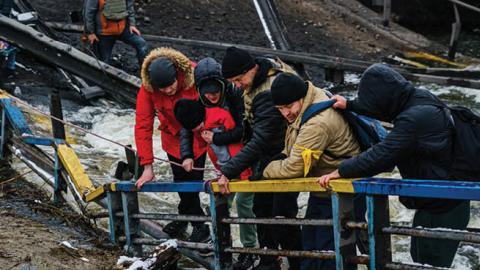We fear the world is only witnessing the beginning of Russian President Vladimir Putin’s madness. The West should not rely on Russia’s invasion of Georgia in 2008 or its assault of Ukraine in 2014 as models for Mr. Putin’s next steps. Those wars were comparatively modest conflicts with only a fraction of Russian manpower committed. In both wars, Russia achieved its objectives rapidly and Mr. Putin never felt backed into a corner.
This conflict is different, and we should instead look to the lesson of Mr. Putin’s first war against Chechnya to understand the depravity of which he is capable. After mysterious bombings flattened Russian apartment buildings in September 1999 — long suspected of being orchestrated by the Kremlin or Mr. Putin himself as a false-flag attack — Russian forces stormed into the province of Chechnya.
After encountering weeks of persistent resistance from Chechen separatist fighters, the Russian forces escalated their tactics, intentionally firing Scud missiles at a marketplace and maternity hospital in the Chechen capital city of Grozny, killing more than 100 civilians including dozens of women and new-born babies. Mr. Putin’s months-long siege of Grozny reduced 90% of the city to rubble. Russian artillery and bombs leveled buildings until all resistance fighters were systematically eliminated. Survivors even claimed that in one town dozens of civilians were beheaded by Russian soldiers.
As Ukraine continues to fight for its survival and its brave soldiers frustrate Russian forces, Mr. Putin and his war machine will resort to increasingly brutal and inhumane tactics. If the West does not increase support to Ukraine, cities like Kyiv and Mariupol will be entirely surrounded and the Ukrainian resistance, along with innocent civilians, will be systematically snuffed out. Indeed, we can already see it beginning, with the indiscriminate Russian carpet bombing of Ukraine’s second-largest city, Kharkiv. Dozens of civilians are dead and more wounded.
President Volodymyr Zelenskyy and the Ukrainian people have surprised the world. Through inspiring fortitude and passion, they have turned the hearts of leaders across Europe to take action, often in ways that have surprised us. But the actions taken to date by Europe and the United States are not enough to halt Putin’s bloodlust. We must do more. Time is of the essence. Every further day of war brings Ukraine closer to collapse and hundreds more Ukrainian casualties.
Unfortunately, for the past year, the Biden administration has systematically refused to lead in taking difficult but necessary measures, first to deter Russia’s invasion, and now to incur enough costs on Russia and Mr. Putin to change his mind and end the war. Month after month last year, Mr. Biden delayed shipments of military aid to Ukraine. Now that a new military aid package has been approved, 72 hours into the war, Ukraine will finally get Stinger missiles directly from the U.S. Many of our allies donated from their stockpiles weeks ago. Pacifist Germany donated 500 such missiles days before the Biden administration.
The United States’ economic consequences have likewise been entirely insufficient to make Mr. Putin rethink his invasion or to develop a regime-threatening domestic backlash. Last Friday, the Russian stock market rebounded 20% after the initial sanctions were discovered to be even lighter than anticipated. Though the U.S., U.K., and European Union are slowly ratcheting up sanctions, this approach is entirely insufficient to deliver the kind of massive jolt necessary to change Mr. Putin’s mind. We cannot wait months for the damage to set in.
The United States and Europe have fully sanctioned some Russian banks and severed them from the SWIFT financial messaging system. They have also put in place export controls and prohibitions on Russian debt, which will gradually make Russian state-owned enterprises uncompetitive. But they haven’t yet placed full blocking sanctions on the Central Bank of Russia or the entirety of Russia’s financial system. Such an action would paralyze the Russian economy. As long as we leave Russian banks unsanctioned, there are serious loopholes through which Russia can bring in hard currency and prop up the rouble.
We should also immediately take the strongest sanctions against Russia’s other economic sectors and key economic jewels, such as its raw minerals, metals and timber industries. We can deploy measures against Russia’s large, state-owned enterprises like Rosatom, Aeroflot and Yandex that are worth hundreds of billions of dollars — these sanctions would not trigger massive spikes in energy prices that the Biden administration and Europe are wary of risking.
Mr. Biden should take cues from the Trump administration’s creative campaigns of maximum economic pressure against Venezuela and Iran that helped cripple those countries’ economies and generated enormous internal discontent against their despotic leaders that could have, if seen to completion, toppled those regimes. The half-measures taken to date are simply not fast-acting or comprehensive enough to change Mr. Putin’s calculus.
The signs of Mr. Putin’s growing madness are emerging, from his threats and hints about the use of nuclear weapons to the potential deployment of thermobaric and chemical weapons. As Ukrainian resistance continues to mount, so will Mr. Putin’s willingness to take barbaric actions that the West cannot yet imagine. We must not let those crimes against humanity transpire. We dread the moment — perhaps only weeks from now — when we look back at today and wonder what more we should have done. The needed actions are clear, and Mr. Biden must show leadership and take them now.
Read in The Washington Times















